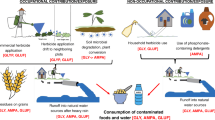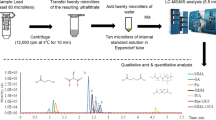Abstract
Glycocholic acid (GCA) has been identified as endogenous biomarker for hepatocellular carcinoma (HCC). To dissolve protein and liberate GCA from protein, ionic liquids (ILs) that contain chaotropic ions were used for pretreatment of liquid biological samples. Coupling with solid-phase extraction (SPE) and reversed-phase high-performance liquid chromatography (RP-HPLC), the novel sample pretreatment method was applied for quantitative determination of GCA in urine and plasma samples. Compared with the traditional organic solvents pretreatment of biological samples, the proposed method is “greener” and simpler, due to no use of volatile organic solvent, and avoiding centrifugation. Under the optimal conditions, when the GCA-free urine and plasma samples were spiked with GCA at 0.05–1.0 and 0.2–10 μmol L−1, the recoveries of GCA ranged between 95.8–101.6 and 96.9–100.4%, respectively. These procedures only required 1 mL of urine and 3 mL of 3 mM ILs aqueous solution and 100 μL of plasma and 4 mL of 2 mM ILs aqueous solution, respectively. The proposed method has been successfully validated on a small sample size of 14 HCC patients and 14 healthy volunteers. For HCC patients, the mean concentration of GCA was 24.79 ± 6.86 and 31.98 ± 11.12 μmol L−1 in urine and plasma samples, and was about 3 times and 24 times as much as in healthy people, respectively. The proposed method opens up a new possibility in early diagnosis of HCC.






Similar content being viewed by others
References
Polson C, Sarkar P, Incledon B, Raguvaran V, Grant R (2003) Optimization of protein precipitation based upon effectiveness of protein removal and ionization effect in liquid chromatography–tandem mass spectrometry. J Chromatogr B 785(2):263–275
Zafarani-Moattar MT, Hamzehzadeh S (2010) Salting-out effect, preferential exclusion, and phase separation in aqueous solutions of chaotropic water-miscible ionic liquids and kosmotropic salts: effects of temperature, anions, and cations. J Chem Eng Data 55(4):1598–1610
Wu ST, Ouyang Z, Olah TV, Jemal M (2011) A strategy for liquid chromatography/tandem mass spectrometry based quantitation of pegylated protein drugs in plasma using plasma protein precipitation with water-miscible organic solvents and subsequent trypsin digestion to generate surrogate peptides for detection. Rapid Commun Mass Spectrom 25(2):281–290
Fic E, Kedracka-Krok S, Jankowska U, Pirog A, Dziedzicka-Wasylewska M (2010) Comparison of protein precipitation methods for various rat brain structures prior to proteomic analysis. Electrophoresis 31(21):3573–3579
Wang X, Fang Q, Liu S, Chen L (2012) The application of pseudo template molecularly imprinted polymer to the solid-phase extraction of cyromazine and its metabolic melamine from egg and milk. J Sep Sci 35(12):1432–1438
Fauzi AHM, Amin NAS (2012) An overview of ionic liquids as solvents in biodiesel synthesis. Renew Sust Energ Rev 16(8):5770–5786
Passos H, Freire MG, Coutinho JA (2014) Ionic liquid solutions as extractive solvents for value-added compounds from biomass. Green Chem 16(12):4786–4815
Marr AC, Liu S (2011) Combining bio-and chemo-catalysis: from enzymes to cells, from petroleum to biomass. Trends Biotechnol 29(5):199–204
Wang G, Zhang L, Zhang J (2012) A review of electrode materials for electrochemical supercapacitors. Chem Soc Rev 41(2):797–828
Berthod A, Ruiz-Angel MJ, Huguet S (2005) Nonmolecular solvents in separation methods: dual nature of room temperature ionic liquids. Anal Chem 77(13):4071–4080
Pan L, LoBrutto R, Kazakevich YV, Thompson R (2004) Influence of inorganic mobile phase additives on the retention, efficiency and peak symmetry of protonated basic compounds in reversed-phase liquid chromatography. J Chromatogr A 1:63–73
Cheng DH, Chen XW, Shu Y, Wang JH (2008) Selective extraction/isolation of hemoglobin with ionic liquid 1-butyl-3-trimethylsilylimidazolium hexafluorophosphate (BtmsimPF 6). Talanta 75(5):1270–1278
Quental MV, Caban M, Pereira MM, Stepnowski P, Coutinho JA, Freire MG (2015) Enhanced extraction of proteins using cholinium-based ionic liquids as phase-forming components of aqueous biphasic systems. Biotech J 10(9):1457–1466
Flieger J, Czajkowska-Żelazko A (2015) Plasma sample preparation for solid phase extraction of chosen xenobiotics, utilizing salts differing in ion chaotropicity. J Liq Chromatogr R T 38(2):182–189
Flieger J, Czajkowska-Żelazko A (2013) Usefulness of the chaotropic effect in sample preparation for chromatographic analysis of acidic xenobiotics in human plasma. J Sep Sci 36(18):3035–3041
Zhang A, Sun H, Yan G, Han Y, Ye Y, Wang X (2013) Urinary metabolic profiling identifies a key role for glycocholic acid in human liver cancer by ultra-performance liquid-chromatography coupled with high-definition mass spectrometry. Clin Chim Acta 418:86–90
Hochberg RB (1998) Biological esterification of steroids. Endocr Rev 19(3):331–348
Rageh AH, Pyell U (2013) Imidazolium-based ionic liquid-type surfactant as pseudostationary phase in micellar electrokinetic chromatography of highly hydrophilic urinary nucleosides. J Chromatogr A 1316:135–146
Flieger J, Siwek A, Pizoń M, Czajkowska-Żelazko A (2013) Ionic liquids as surfactants in micellar liquid chromatography. J Sep Sci 36(9–10):1530–1536
Cacace M, Landau E, Ramsden J (1997) The Hofmeister series: salt and solvent effects on interfacial phenomena. Q Rev Biophys 30(03):241–277
Tagliacozzi D, Mozzi AF, Casetta B, Bertucci P, Bernardini S, Ilio CD, Urbani A, Federici G (2003) Quantitative analysis of bile acids in human plasma by liquid chromatography–electrospray tandem mass spectrometry: a simple and rapid one-step method. Clin Chem Lab Med 41(12):1633–1641
Author information
Authors and Affiliations
Corresponding author
Ethics declarations
The authors have declared no conflict of interest.
This study was approved by the Ethical Committee of Xingtai Health Bureau. Written informed consent was obtained from each patient for the use of his/her urine and plasma samples.
Rights and permissions
About this article
Cite this article
Li, H., Zhao, H., Li, Q. et al. Analysis of Glycocholic Acid in Human Plasma and Urine from Hepatocellular Carcinoma Patients. Chromatographia 80, 209–215 (2017). https://doi.org/10.1007/s10337-016-3237-3
Received:
Revised:
Accepted:
Published:
Issue Date:
DOI: https://doi.org/10.1007/s10337-016-3237-3




